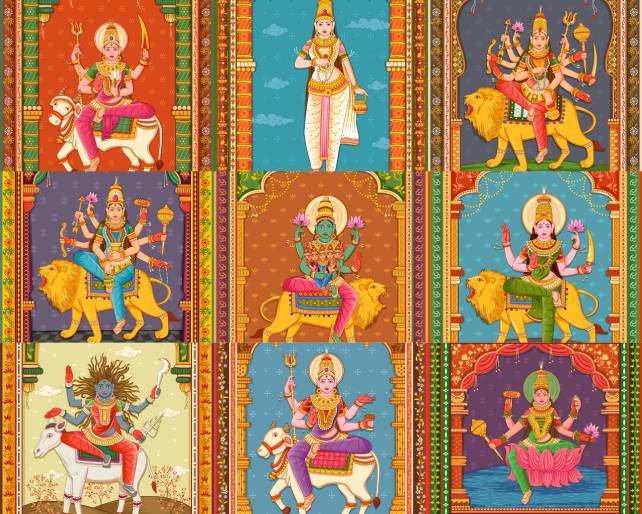The symbolism and archetypes embedded in stories handed down to us intergenerationally when paid close enough attention to are rich with clues to support the unfolding of our inner and outer journeys. According to the Sankhya philosophy, all manifestations of life are considered to be Prakriti (feminine).The feminine has also held a vital and revered place in the tradition in the form of Durga with her different forms that come alive during the 9 -day festival of Navaratri each year when her stories are shared anew with the young generation.
A 3-day workshop on connecting with the feminine was anchored by Sashikala Ananth in collaboration with Jyotsna Narayanan for an all-women group of Bharatnatyam dancers recently where the group explored various aspects of being a woman in today’s world with the final session on NavaDurga and reflections on her various forms and meaning she brings into their lives, in turn creating a space for the dancers to find reference in Durga’s various forms as women seekers seeking to connect more deeply to their own paths.
While one version of the festival Navaratri celebrates the confrontation and victory of Rama and Ravana, the second version of the festival focuses on celebrating the different forms of the feminine- the first week being dedicated to Durga, the second to Mahalakshmi and the third to Mahasaraswathi, the three Mothers.
It is believed that as an individual, when one is confronted with his/her own inner asuric qualities, he/she can awaken to a deeper, spiritual path by calling upon MahamAya or MahaKali and with her firm sternness she further wakes up the individual to follow the path more steadily.
The seeker or sadhaka then awake is then supported by Mahalakshmi and Mahasaraswati who bring to the individual the physical, material means as well as the right knowledge and teachings to pursue the spiritual path.
The nine different forms of Navadurga touched upon in the session are as follows. They remind us of all the abilities, skills, knowledge and powers a woman is capable of gathering as she transitions through the various stages of her life in the various roles she is called to play
from her childhood where she is yet to discover her full potential;
to the spiritual seeker where she turns inward;
to the householder and warrior where she engages with her powers in the interplay of creation and destruction in the world outside of her;
and to the final transition of merging with the Divine where she reaches her fullest potential and is in union with the Divine masculine.
Recording of session with Sashikala Ananth explaining the various aspects of Navadurga is available here
Shailaputri represents Parvati in her stage of childhood. ‘Shail’ translates to ‘mountain’- she is the daughter of the Mountain King, Lord Himavan and Queen Menavati. After having given up her Sati form, the Goddess has taken birth in the avatara of Shailputri Parvati. Since her birth, she experiences a feeling of attachment towards Lord Shiva. Goddess Parvati had taken her birth as an ordinary woman to attain the position of a goddess in her journey to become one with Lord Mahadev. She is that avatar of a little daughter who makes a family, her parents happy, joyous and proud of her.
Shailputri is milk white in complexion- white her signifying innocence- with three content eyes as well as a calm mien. She is adorned by light ornamentation on her limbs and is clothed in red and pink robes. She has two hands both holding a trident and lotus. She is seated upon the behind of a white bull.
Brahmacharini represents Parvati in her phase of asceticism. Parvati attains this epithet from performing austere and harsh penances to have Lord Mahadev as her husband for years. This form of her is close to her because as Parvati, she meditates to become one with Shiva again as Shakti, ensuring that her motive is complete. For her to be Brahmacharini, not only does Parvati wake up Shiva from his penances, but rather, this form of hers awakens within her in which she breaks out of living life as a ordinary human. She is a student and a disciple who makes it her mission to attain the goals of her life through the harsh period of her education. Brahmacharini is of a fair complexion, with three content eyes as well as a calm demeanour. She is dressed as a female ascetic and is adorned by dried up Rudraksha beads and flowers as her ornamentation. She has two hands, both of which carry a rosary and a water utensil.
Chandraghanta represents Parvati in her married aspect. Parvati was given this title by Lord Shiva, due to her wish to have Lord Chandradev, the Moon God, adorn her forehead just as he adorns Lord Shiva’s matted hair, giving him his name as Chandrashekara. On fulfilling her wish, Lord Shiva transforms her bridal guise into a new form with a new name. Adorned by the crescent moon on her forehead, Parvati hence comes to be called Devi Chandraghanta. She is also that aspect of a woman who is independent and fights to establish justice, peace and makes her voice heard to bring about positive changes.
Chandraghanta is of gold complexion, with three bloodshot eyes and a calm face. She is adorned by heavy ornamentation on her limbs and was dressed in red apparel. Her crown is decorated by the logo of the half moon. She has ten hands, nine of them are armed by a trident, mace, bow, arrow, lotus, sword, bell and a waterpot, while one other hand blesses her devotees. She is seated upon a fierce tiger.
Kushmanda represents Devi Parvati in her stage of discovering that she is none other than Mahashakti. After their marriage, Lord Shiva by mirroring her helps Goddess Parvati realise her true existence. This form of her is known the world as Kushmanda, as she holds within her, many endless powers of the world. Shiva helps her realize that she is not just a human but a Goddess, the Mother of the World and all of creation, the Creator of the three planes through her golden womb. She is that aspect of woman who brightens up the lives of those around her by bringing great joy. Kushmanda is of a gold complexion, with three peaceful eyes and a calm mien. She is adorned by ornaments on her limbs and is dressed in pink and yellow. She has eight hands, six of which hold a discus, mace, lotus, bow and arrow, sword, rosary, a jar of honey and waterpot. She sits mounted on a tiger.
Skandamata represents Devi Parvati in her stage of motherhood. Parvati is known to be the mother of Skanda or Kartikeya. The seed of the energy that Shiva and Parvati create fall on a sleeve of reeds and get split into six infants who are later found by six women or Krittikas. Parvati is kept away from nurturing her child from the six Krittikas. After working out a fair resolution, Shiva and Parvati decide to merge the six babies into one infant with six faces. He would be known to all as Shanmukha (six-faced) and as a being the mother of this unique child, Parvati comes to be known as Skandamata. The boy is also known as Kartikeya as he is found by the six Krittikas- he is their child as well as that of Shiva and Devi. Skandamata represents maternity, affection, and love in a woman. She is the mother to any child that comes to her- biological/ adopted.
Skandamata is of a gold complexion, with three eyes as well as a calm mien. She is adorned with light ornamentation on her limbs and is dressed in orange and yellow apparels. She has four hands, two of which held lotuses, the third holding her son, the six-headed infant Kartikeya seated on her lap, and the fourth saves her devotees. She is seated upon the back of a lion.
Katyayani represents Parvati in her warrior stance. When the Gods invoke Mahashakti to protect them from demon Mahishasura, Parvati materializes from a sacrificial fire in the avatar of a ten armed Goddess. She is known to the world as Katyayani, having taken birth in the home of the sage Katyayan as his daughter and having killed the dreaded demon Mahishasura after a long fight. She is that avatara of a woman who shows that she is not vulnerable when the question of protecting her own is brought up. She if the protector of both men and women. Katyayani is of a molten gold complexion, with three staring eyes and a relaxed face. She is adorned by heavy ornamentation on her limbs and is dressed in green and pink. Her four hands each carry a sword, shield, lotus and trident. She is seen seated on a fearsome lion.
Kaalratri represents Parvati in her phase of destruction. She is called the Goddess of time and death because she is above and beyond their control. She controls time in which someone’s death arrives and she is beyond darkness. She is also that aspect of a woman who is constantly enraged by injustices and fights them to save society. She is aggressive and can bring about destruction when her threshold is crossed. Kaalratri is of a pitch dark complexion and has a ferocious expression. She is adorned in electric ornamentation on her limbs and is clothed in red and black robes. She has three bloodshot eyes, unkempt hair, and wears a garland of skulls around her neck that shines like lightning. Her four hands all hold a trident, scimitar, vajra, and a cup. She is seated upon the behind of a donkey as her vehicle.
Mahagauri represents Parvati in her phase of recovery. After she embraces her form of Kali, Parvati returns to her normal form but with skin as black as night. On Lord Brahma’s direction, she immerses herself in the Manasarovara river and emerges afterward, radiant as the moon and shining brilliantly with her white garments and ornaments. This form of Parvati is known to the world as Mahagauri. She is that avatar of a woman who is the homemaker, devoted wife, and a nurturing mother- the holder or foundation of the family. Mahagauri is of a bright white complexion, with three peaceful eyes as well as a calm expression. She is adorned by light white ornamentation on her limbs and is dressed in white clothes. She has four hands, three of which carry a trident, a mini-drum and a pink lotus while her fourth hand promises protection to her devotees. She is seated upon a white bull.
Siddhidhatri represents Devi Parvati in her final stage of awakening to her highest and supreme form, knowing who she is as the complete manifestation of Goddess Mahashakti. Siddhidatri has all the supernatural powers and is one with Lord Shiva as Ardhanarishwara. She is that avatar of a woman that represents the very source of life and imparts education, teaching skills, and discipline to the young. Siddhidhatri is of a fair complexion, with three content eyes, emanating calmnness and serenity. She is adorned by light ornamentation and is dressed in red and blue. Each of her four hands carry a discus, conch shell, trident, and a mace. She is seated on a fully bloomed lotus.
Which form of Durga inspires or resonates with you the most? You can leave comments below to continue the discussion on Durga and her many forms.



 Priya is a Yoga therapist in the Krishnamacharya tradition. She adapts Reiki & energy work, Vedic chanting, life coaching & Ayurvedic practices in her healing spaces. She is committed to nurturing collectives that have the praxis of Yoga at their heart.
Priya is a Yoga therapist in the Krishnamacharya tradition. She adapts Reiki & energy work, Vedic chanting, life coaching & Ayurvedic practices in her healing spaces. She is committed to nurturing collectives that have the praxis of Yoga at their heart. Anisha has been on an exploration to understand herself through yoga for the last 15years which led her to teaching yoga, yoga therapy and inner work through yoga.
Anisha has been on an exploration to understand herself through yoga for the last 15years which led her to teaching yoga, yoga therapy and inner work through yoga. Apoorva chanced upon Yoga in her early 20s. A spark was lit within and there was no turning back. Her exploration led her to the Krishnamacharya tradition more than a decade ago. Curious about human behaviour and what drives it, she was thrilled when her search ended (and also began) when she first came upon the Yoga Sutra, which illuminated a path towards answering many questions that had been held for a long time.
Apoorva chanced upon Yoga in her early 20s. A spark was lit within and there was no turning back. Her exploration led her to the Krishnamacharya tradition more than a decade ago. Curious about human behaviour and what drives it, she was thrilled when her search ended (and also began) when she first came upon the Yoga Sutra, which illuminated a path towards answering many questions that had been held for a long time. Anita is a yoga teacher and therapist in the tradition of Sri.T.Krishnamacarya and Sri T.K.V. Desikachar, a Reiki practitioner and a Life Coach. She is also the founder of Vishoka, a center for learning Indic and energy-based frameworks for living and healing. Her deep concern for human suffering and the problems of unsustainable living kept her on the path of seeking an integrated approach to looking at life, living, learning and healing.
Anita is a yoga teacher and therapist in the tradition of Sri.T.Krishnamacarya and Sri T.K.V. Desikachar, a Reiki practitioner and a Life Coach. She is also the founder of Vishoka, a center for learning Indic and energy-based frameworks for living and healing. Her deep concern for human suffering and the problems of unsustainable living kept her on the path of seeking an integrated approach to looking at life, living, learning and healing. Ankit is a seeker in the wisdom traditions of India. The core of his work includes creating dialogic spaces where people can look within and see the connection between their inner and outer lives. Inspired by the likes of Gandhi, Aurobindo, Vivekananda and Guru Gobind his experiments in service took him back to his roots in Punjab where he is creating a community-led model of higher education which is open, inclusive and accessible for all. Ritambhara for him is a space for engaging in a community which is committed to a DHramic life. He anchors his work of learning and leadership in the Antaranga Yoga Sadhana and the humanistic wisdom of Mahabharata.
Ankit is a seeker in the wisdom traditions of India. The core of his work includes creating dialogic spaces where people can look within and see the connection between their inner and outer lives. Inspired by the likes of Gandhi, Aurobindo, Vivekananda and Guru Gobind his experiments in service took him back to his roots in Punjab where he is creating a community-led model of higher education which is open, inclusive and accessible for all. Ritambhara for him is a space for engaging in a community which is committed to a DHramic life. He anchors his work of learning and leadership in the Antaranga Yoga Sadhana and the humanistic wisdom of Mahabharata.